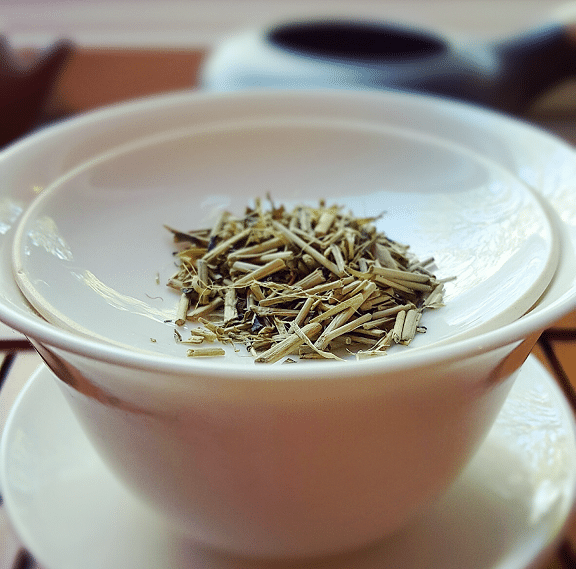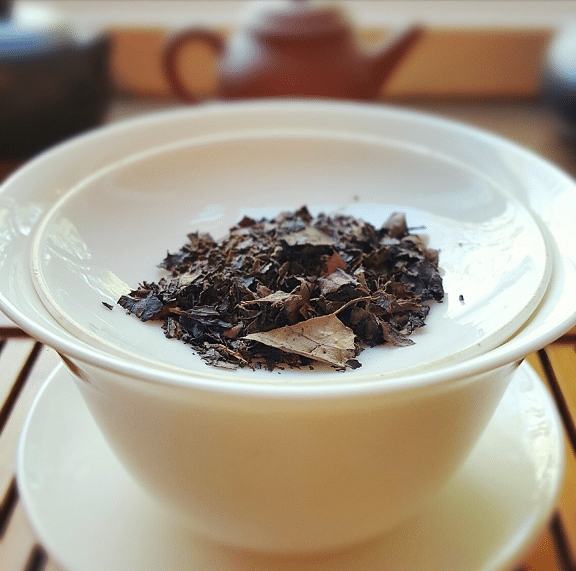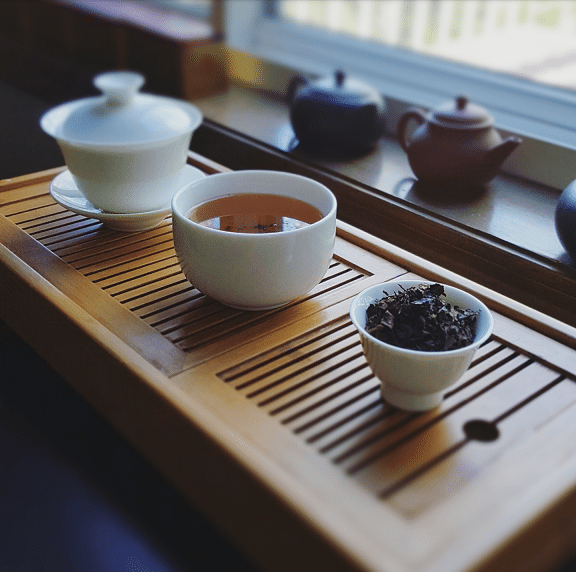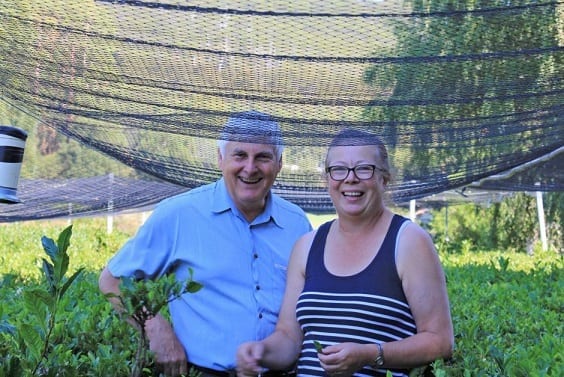Australian Tea Week, Day 2: “Effie’s Tea Offerings”
This is Effie Gidakos . . .

She’s a tea nerd, like I am. She even takes to social media (and local radio) about her love of tea. She’s also obsessed with Christmas (obviously). And—per this week’s theme—she’s also Australian.
I first met her at World Tea Expo this last summer.

Let me tell ya, she was an absolute delight. Full of youthful tea-drunken exuberance. I couldn’t even keep up with her enthusiasm level, and believe me . . . I tried. But this isn’t just about her particular firebrand of optimistic Ozzie-ness; oh no. She came to World Tea Expo with teas from her neck of the globe.
From the pile of wonders (from Down Under), I called “Dibs!” on a Tasmanian black tea (sold by Art of Tea), and a mysterious Japanese style kukicha (sold by Perfect South).

I dipped into both a couple of times over the course of months, but I didn’t set aside session to fully delve into them until mid-autumn. My biggest gripe? I had no clue what gardens they came from. The vendors left that information conspicuously absent. And at the time, I gave it a big ol’ shrug of “whatever”, and went to drinking.
When I think of kukicha, I think of . . . exactly what it means in Japanese; “twig tea”. That’s exactly what it is, the twigs and stems of the tea plant. It’s whatever is left over after the leaves have been plucked or cut. Most of the time, the stems are just as green as the leaves. These were markedly different; the stems were pure albino yellow. All of ‘em; the same color, it was weird. The aroma they gave off was equally left-of-normal. Instead of smelling like leaf-kindling, they possessed an aroma of roasted, vanilla-lathered nuts.

Brewing instructions on the bag said to bring water to a boil, and then let it cool, before adding it to 1-2 heaping teaspoons of leaves. Since I had a variable temperature dial on my kettle, I simple turned it to the green tea setting, and let it to its thing. Afterwards, I added the water to a gaiwan that housed the aforementioned heaping teaspoon of stems. I let it steep for about a minute.
Note to self: When brewing kukicha in the future, don’t use a gaiwan. Little twigs got everywhere when I brewed this. I mean, everywhere. Some even got on the window sill, I think. Still can’t find ‘em. Moving on . . .

The liquor brewed to a pale green gold, similar to the color of the stems themselves. The steam aroma was all citrus-laden vanilla nuts . . . with a dash of grass. Y’know, to remind the drinker that this was still a green tea. On taste, the front was basically lemongrass. Not quite as citral-heavy, but still very lemongrassy on delivery. It didn’t really turn into a “green tea”-ish taste until around the middle. The top note was a little nutty (in both senses of the word) before delving back into familiar grass-‘n-herbal territory. In short, not your typical kukicha, and I was fine with that.
The Art of Tea Tasmanian Black Tea
The Tasmanian black tea didn’t give much of a first impression. Reason? The leaves were fannings grade. That and they were similar to Daintree in both leaf cut and aroma, but different enough to warrant merit. Unlike a lot of fannings grade teas, this had an aroma that was all its own. Most low-cut, high-yield teas tend to give off a scent of . . . “freshly-mowed farm”. It’s not an unappealing scent, but it gives no impression of terroir or character. This had character.

The leaf aroma was woodsy, a little earthy, and had an herbaceous tickle on the backend. Honestly, it was what Indian tea estates pass off as oolongs these days. The smell was straight-up semi-oxidation.
For brewing, I simply treated it like I would any other black tea—1 heaping teaspoon of leaf to a 6oz. gaiwan. Boiled water, three minute-steep. Nothing to see here, move along.
Note to self again: When brewing tea leaf fannings, don’t use a gaiwan. They get everywhere. Again! One would think I’d know better by now.

The liquor brewed to a soft, almost woodsy brown, with an aroma of cedar right before a campfire. No, not a smoky smell, just a “ready-to-be-smoked” smell; does that make sense? It was a very rustic fragrance that made me wish I was more of an outdoorsman. Given that I was in my pajamas at the time of the tasting, that moment soon passed.
The flavor was all over the place . . . in the best possible way. There were notes of Wuyi rock oolongs, bourbon-scented Assams, and oak-roasted Darjeelings. And that was just the first sip. The rest of the flavor was some weird amalgamation of sensations—all recognizably “black tea”-ish, but somehow new and unexplored. Some of the fannings-related floral nature was there, but it was muted by a huckleberry/walnut finish. At least, that’s what I thought that aftertaste was. It lingered quite a bit.
If I were to choose a favorite—in the realm of taste—the prize would go to the kukicha. For every day, cozy drinking, though? The Tasmanian black tea was just so darned comfortable, amiable on the tongue, and reliable. One could also brew it every which way and not screw it up.

But the question still nagged at me: Where did these two teas come from? I can understand the reason why teashops keep their sources a secret. They don’t want others stealing their propriety. But I’m a storyteller, dammit, and we’re curious bastards by nature. So . . . I went to sleuthing.
I had Effie contact Art of Tea for any further information on the Tasmanian black. All she was able to turn up was a location—Allens Rivulet. Perfect South wouldn’t even respond to hails.
On Monday night, I made a breakthrough on the kukicha, thanks to an article on World of Tea—written by David Lyons of 18ThirtyFour.

In it, he talked about tea growing efforts in the Alpine region of Victoria, Australia. Several small gardens fed into a factory in Wangaratta, owned by Ito En. Not only that, David Lyons also recommended that the reader check out Perfect South for further inquiries about Australian green tea. While I didn’t have an exact garden pinned out, I did have a factory and a region. I considered this case closed.
Now, it was Tasmania’s turn.
I spent almost two hours looking for mentions about a Tasmanian tea garden. Either I was (and still am) a complete idiot, or I was just too damn tired the night I was looking. The answer was right in front of my face. On the very same article by David Lyons I just looked at.
In his write-up, he had a link to another article by Carol Rääbus of 936 ABC Hobart, which featured these two:

Gordon and Jane Brown, agriculture scientists, apple orchard caretakers, and . . . tea growers in Allens Rivulet, Tasmania. Apparently, they’d been at the tea growing game for a while—since the early 90s. I even found their (very 90s) website.
Mission(s) accomplished!
Have I mentioned how fun this Australian tea search has been? Yeah, it’s been way fun. By the end of this week, I might even be as exuberant as Effie.

Okay . . . maybe only almost as exuberant.
Leave a Reply